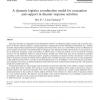Free Online Productivity Tools
i2Speak
i2Symbol
i2OCR
iTex2Img
iWeb2Print
iWeb2Shot
i2Type
iPdf2Split
iPdf2Merge
i2Bopomofo
i2Arabic
i2Style
i2Image
i2PDF
iLatex2Rtf
Sci2ools
EOR
2007
2007
A dynamic logistics coordination model for evacuation and support in disaster response activities
This paper describes an integrated location-distribution model for coordinating logistics support and evacuation operations in disaster response activities. Logistics planning in emergencies involves dispatching commodities (e.g., medical materials and personnel, specialised rescue equipment and rescue teams, food, etc.) to distribution centres in affected areas and evacuation and transfer of wounded people to emergency units. During the initial response time it is also necessary to set up temporary emergency centers and shelters in affected areas to speed up medical care for less heavily wounded survivors. In risk mitigation studies for natural disasters, possible sites where these units can be situated are specified according to risk based urban structural analysis. Logistics coordination in disasters involves the selection of sites that result in maximum coverage of medical need in affected areas. Another important issue that arises in such emergencies is that medical personnel...
EOR 2007 | Medical | Medical Personnel | Model |
| Added | 13 Dec 2010 |
| Updated | 13 Dec 2010 |
| Type | Journal |
| Year | 2007 |
| Where | EOR |
| Authors | Wei Yi, Linet Özdamar |
Comments (0)

